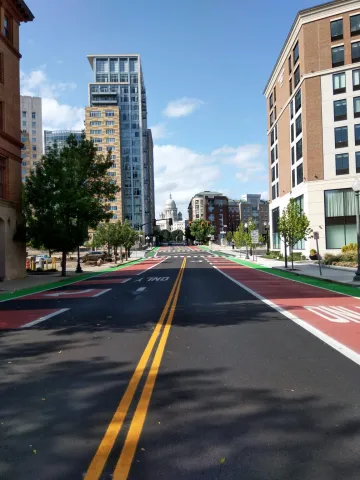
Which bus routes serve the DTC? +
RIPTA Routes 3, 4, 51, 54, 58, and 72 operate along the corridor. Routes 1 and 92 also serve some DTC stops.
Why don’t more RIPTA routes travel along the DTC corridor? +
We believe a 5-minute frequency is appropriate to meet passenger demand in the downtown DTC corridor. Some routes (i.e. RIPTA Routes 1 and 92) serve certain DTC stops, but not the entire corridor. Additional routes could travel via the corridor in the future.
Where are dedicated bus lanes located? +
Dedicated bus lanes are located: along Eddy Street (north of RI Hospital) and near South Street Landing; on Dyer Street (in the southbound direction near the new Wexford development); and along Exchange Street (between Kennedy Plaza and Providence Station). Bus lanes are also located at all DTC stop locations, including the full northbound block of Dorrance Street between Friendship and Pine and the southbound block between Weybosset and Pine.
What types of vehicles are used? +
RIPTA is using buses from our regular bus fleet. However, as we continue to transition to electric buses it is likely that some of these buses will operate along the DTC.
Can other vehicles use the bus lanes? +
Emergency vehicles are able to use DTC bus lanes, as well as any vehicle making the next available right-turn.
How are “no parking” and “no driving” rules in the bus lanes enforced? +
RIPTA and the City of Providence are working together to establish rules for the bus lanes. New legislation or ordinances may be required. We also believe it will be important to conduct a campaign to educate downtown drivers about any restrictions.
Will any dedicated bicycle lanes be added? +
Bicycle lanes were installed on Exchange St. leading to Providence Station, and possibly on certain segments in the Jewelry District. For safety reasons, bicycles are not allowed in the dedicated bus lanes.
What is Transit Signal Priority (TSP) and how does it work along the DTC? +
Transit Signal Priority (TSP) adjusts the timing of a traffic signal’s red and green cycles to reduce the amount of time a transit vehicle spends waiting at a red light. Extending green lights for buses along the R-Line reduced the overall travel time by 10%. We believe it will reduce future bus travel times along the shorter DTC corridor between RI Hospital and Providence Station by about 20%. TSP will also make travel times along the DTC more reliable, which will help create a service more people can depend on.
What type of information is displayed at DTC stops? +
Real-time information displays show bus schedules as well as changes and disruptions to service. These smart displays also offer additional information about area attractions and events. If you have any suggestions for information you would like to see or that will make your trip easier, please let us know.
How was the DTC project funded? +
There was $17 million available to design and construct the project, including a $13 million federal grant for the project and $4 million from RIPTA and the State of Rhode Island.
How are stops and shelters along the route maintained? +
RIPTA cleans and maintains bus shelters using in-house maintenance staff or private contractors. Unfortunately, with about 3,500 bus stops in our statewide system, we are not able to remove snow at all locations. However, we may try to find local partners to adopt DTC stops for light cleaning and snow removal.
We carefully considered maintenance needs as part of our design process and have constructed shelters and other amenities to be as resistant as possible to damage and vandalism. Instead of glass panels, we used a polycarbonate material and RIPTA has an inventory of replacement panels on hand in case of damage.
